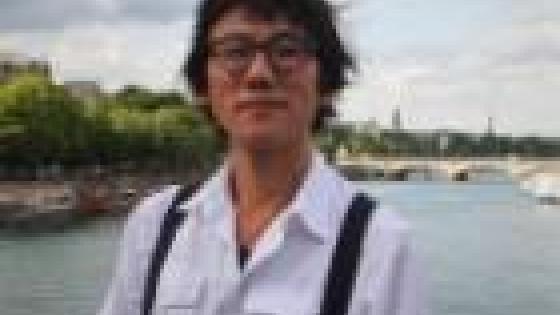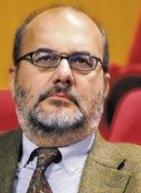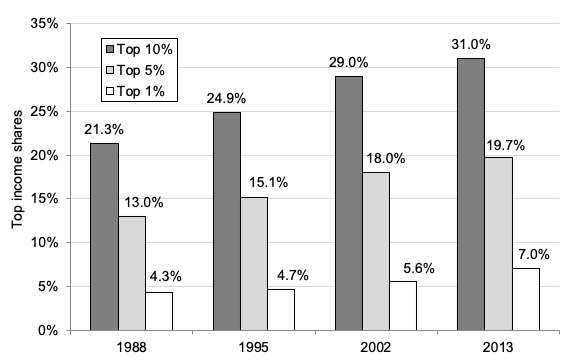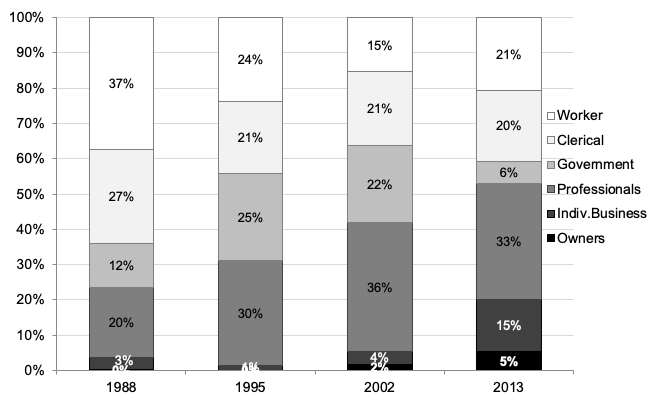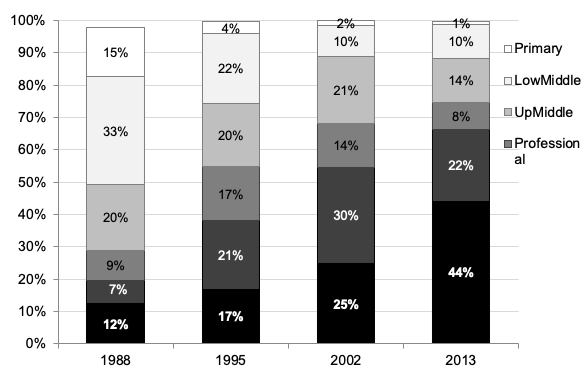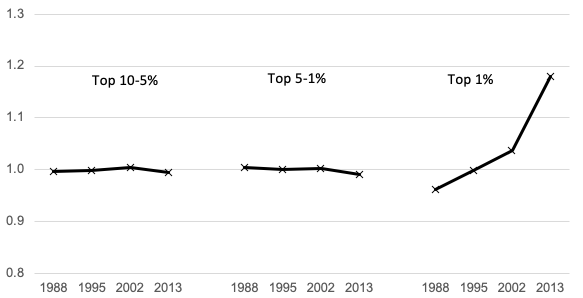The transformation of China from a poor and egalitarian country to an upper-middle-income country with a level of income inequality greater than that of the US has been the subject of innumerable publications and policy discussions. The Chinese transformation is a unique event in world economic history – never have so many people over such a relatively short period of time increased their income so much. China’s GDP per capita in 1978, at the time of the initiation of rural reforms, was about $1,500; by 2015, it was more than $12,000 (both in constant PPP dollars).2 In comparison, UK GDP per capita was (expressed in the same units) around $12,000 in 1953, while its GDP per capita at the beginning of the Industrial Revolution is estimated at more than $3,000. Thus it took the UK about a century-and-half to increase its GDP per capita by half as much as China did in less than 40 years.
Such transformation is only superficially captured by synthetic indicators like GDP per capita, Gini coefficient, or the share of the top 1% (Kanbur and Zhang 2018, Zhuang and Shi 2016, Ding and He 2018, Wu and Perloff 2008, Xie and Zhou 2014, Piketty et al. 2018). The experienced social changes were much deeper and affected all social classes and their relative positions. The composition and characteristics of the elite were almost completely overhauled.
For social researchers, because the change has taken place so fast — in the span of less than two generations — the Chinese experience offers the advantage that it can be more easily apprehended. Furthermore, the data to assess it empirically exist today while they were lacking during similar episodes in Western economic history and are often only recently reassessed (Allen 2017).
In a new paper (Yang et al. 2019), we aim to describe and analyse the change in the Chinese economic elite between (approximately) the years of early reforms and China’s attainment of its status as the largest economy in the world (in PPP terms). The analysis relies on nationally representative household income surveys – the China Household Income Project (CHIP) – which were drawn from a much larger sample of the Urban Household Survey conducted annually by the National Bureau of Statistics. We use urban samples of four CHIP waves in 1988, 1995, 2002, and 2013. The surveys are comparable, although we have to ‘iron out’ certain idiosyncrasies to make the variables of interest fully harmonised.
The richness of the survey information in CHIP allows us to analyse various features of the urban elite (defined as the urban top-5% income group) and the evolution of these characteristics over time and across regions. We discuss here four characteristics: share of total urban income received by the elite, the elite’s social composition, its education, and Chinese Communist Party (CCP) membership.
Inequality
The income shares of the three top groups increased between 1988 and 2013 (Figure 1). The top 1% share went up from 4.3% in 1988 to 7% in 2013; the share of the elite (top 5%) increased from 13% to almost 20%; and the share of the top decile increased from about 21% to 31%. Similarly, inequality calculated across all adults, and measured by the Gini coefficient, rose from 0.27 in 1988 to 0.45 in 2013. This is an unsurprising result simply confirming what other studies of inequality (cited above) have also found.
Figure 1 Income share of the top 1%, top 5%, and top 10%
Social structure
A new question we ask is whether the social composition of the elite has changed and how. The surveys distinguish six social groups or classes: workers, clerical and office employees, government administration (at all levels), professionals, owners of individual businesses (including the self-employed), and larger-scale owners.
There was a major shift in the composition of the elite toward the two latter (capitalist) classes (Figure 2). In 1988, they accounted for barely 3% of all elite members. Their share doubled to about 6% by 2002, and ‘exploded’ in the next decade, increasing more than three-fold to reach almost 20% in 2013. This speed of social change in China may be contrasted with a recent finding by Bob Allen (2017) who, using standardised social tables for England and Wales (from Gregory King’s 1688 table to Dudley Baxter’s in 1867), found that it took capitalists almost two centuries to more than double their share in population, passing from 3.4% in 1688 to 7.8% in 1867.
Before the important urban reforms in the early 1990s, the Chinese urban elite was overwhelmingly composed of workers, clerical staff, and government officials – together accounting for three-quarters of the people in the top 5% in 1988. By 2013, it had become an elite where professionals and business owners were in the majority.
Figure 2 Social composition of the top 5% (percentage of individuals)
Education
The elite have become much more educated, with the dominant group being those with a university degree, rather than a lower-middle school education (Figure 3). Among the elite, 44% are university educated.
By comparing elite numbers of different educational categories with their shares of total elite income, one interesting conclusion emerges: controlling for elite membership, there are almost no differences in per person earnings between different educational categories. In other words, whereas those with a lower-middle education are now much less likely to make it to elite membership (their share was cut by two-thirds), if they do make it, their income level is, on average, the same as that of the university educated.
Figure 3 Composition of the top 5% according to educational attainment (percentage of individuals)
CCP membership
An interesting question in a de facto single-party state is how much political influence or connections help increase income. It is especially intriguing in China, where the ruling party is officially concerned with the interests of the poorer or less educated sections of the population but where the observed changes clearly paint a picture of the rising importance of well-educated professionals and entrepreneurs.
The share of CCP members among the elite is currently about 30% and among the top 1%, around 25%; these are approximately the same levels as in 1988. However, CCP members who are in the top 1% are nowadays relatively richer, compared to the average income of the rest in the top 1% (Figure 4). In all the years prior to 2013, the relative income of CCP members was about the same as the relative income of other members of the elite, whether we look at the group that comprises 91st-95th percentiles, 96th-99th percentiles, or the top 1%. But in 2013, there was a significant increase in CCP members’ relative income in the highest income group.
Figure 4 Income of CCP members of the elite compared to the average income of all elite
Note: The graph shows the average income of CCP members who are part of the 91st-95th percentiles (left), 96th-99th percentiles (middle), and the top percentile (right) relative to the mean income of that group. Value of 1 indicates that average income of CCP members is the same as the average income of the group (and hence also to the average income of non-Party members).
In general, we find (not shown here) that while professionals’ and workers´ shares in urban CCP membership closely approximate their population shares, professionals who are CCP members have become much more numerous among the top 5%, while workers have become much rarer. In other words, whereas the structure of the overall CCP membership in the recent period better reflects the population structure than in 1988, the CCP top is moving further away from both CCP overall class composition and from that of the urban population as a whole. This might have important political consequences.
This result acquires additional significance when we find in a regression analysis that private-sector business people who are part of the elite and are also CCP members tend to receive a very large premium from CCP membership (34%). This is in contrast with all other social groups to whom CCP membership, once they are elite members, is not financially important. It is also noteworthy that we find no evidence of this large CCP membership premium for private-sector business people in the years before 2013.
Conclusion
Chinese economic and, as we argue, social transformation during the past four decades is without a historical precedent. Urban areas have become much richer, but also much more unequal. The elite, which we define here as the top 5% of the urban population, receive a much greater share of total urban income than in 1988. The majority of the elite today consists of professionals, self-employed, and smaller and larger business people (while workers and clerical staff were in the majority in 1988). The elite are also much better educated than before.
Finally, we find that almost a third of the elite are CCP members and that CCP membership seems to be quite valuable in monetary terms to those in the top 1% as well as to large capitalists. It should be mentioned however that CCP membership might also be a proxy for greater ability and ambition – not necessarily only for better political connections (Li et al. 2007). But without further study, it is difficult to disentangle the two.
References
Allen, R (2017), “Class structure and inequality during the Industrial Revolution: Lessons from England’s social tables, 1688-1867”, draft.
Ding, H, and H He (2018), “A tale of transition: An empirical analysis of income inequality in urban China, 1986-2009”, Review of Economic Dynamics 29: 108-137.
Kanbur, R, and X Zhang (2018), “The great Chinese inequality turnaround”, mimeo, 6 August.
Li, H, P W Liu, J Zhang and N Ma (2007), “Economic returns to Communist Party membership: Evidence from urban Chinese twins”, Economic Journal 117: 1504-20.
Piketty, T, L Yang and G Zucman (2017), “Capital accumulation, private property and rising inequality in China, 1978-2015”, WID.world Working Paper Series 2017/6.
Wu, X, and J Perloff (2005), “China’s income distribution and inequality”, Review of Economics and Statistics 87(4): 763-75.
Xie, Y, and X Zhou (2014), “Income inequality in today’s China”, Proceedings of the National Academy of Sciences 111(19): 6928-33.
Yang, L, F Novokmet and B Milanovic (2019), “From workers to capitalists in less than two generations: A study of Chinese urban elite transformation between 1988 and 2013”, WID.world Working Paper No. 2019/10.
Zhuang, J, and L Shi (2016), “Understanding recent trends in income inequality in the People’s Republic of China”, ADB Economics Working Paper Series, No. 489.
Endnotes
[1] Data from the 2018 update of the Maddison Project Database, available at https://www.rug.nl/ggdc/historicaldevelopment/maddison/releases/maddison-project-database-2018.


